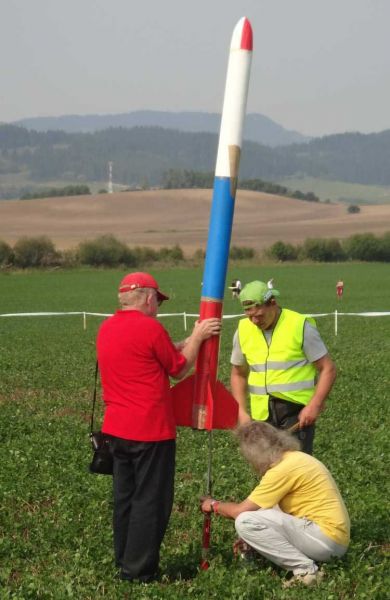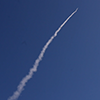 Реклама Google — средство выживания форумов :)
Реклама Google — средство выживания форумов :)
-
![[image]](https://www.balancer.ru/cache/sites/net/ar/arstechnica/cdn/wp-content/uploads/2013/08/128x128-crop/groupShot.jpg)
Успехи иностранных ракетолюбителей II
Теги:
CATO> А теперь, и Шотландские шестиклассники идут на рекорд
Чтобы всем было понятно проектировали и создавали ракету около 2-х лет. Школьники
занимаются только выбором полезной нагрузки на конкурсной основе. Рекорд они побивают
свой же - 2 года назад достигли высоты 10,5 км. Проект был подкреплен £ 10,000 грантом
от Северо-Западного регионального агентства по развитию. Это чуть более 129.000 гривен.
Думаю, за такие деньги можно и у нас чего-нибудь запустить.
Чтобы всем было понятно проектировали и создавали ракету около 2-х лет. Школьники
занимаются только выбором полезной нагрузки на конкурсной основе. Рекорд они побивают
свой же - 2 года назад достигли высоты 10,5 км. Проект был подкреплен £ 10,000 грантом
от Северо-Западного регионального агентства по развитию. Это чуть более 129.000 гривен.
Думаю, за такие деньги можно и у нас чего-нибудь запустить.


planet> Чтобы всем было понятно проектировали и создавали ракету около 2-х лет.
А где можно почитать подробнее? Откуда у тебя данные?
> Школьники занимаются только выбором полезной нагрузки
Да, журналисты, как обычно, всё исказили. А эта фраза вообще убила: "Удалось ли установить рекорд, станет известно только когда удастся найти ее ОБЛОМКИ."
А где можно почитать подробнее? Откуда у тебя данные?
> Школьники занимаются только выбором полезной нагрузки
Да, журналисты, как обычно, всё исказили. А эта фраза вообще убила: "Удалось ли установить рекорд, станет известно только когда удастся найти ее ОБЛОМКИ."


Serge77> А где можно почитать подробнее? Откуда у тебя данные?
Пожалуйста!
Информация БиБиСи
// www.bbc.co.uk
Сайт руководителя проекта Торбена Стига (Torben Steeg) имеет
много фото.
http://bstc-rocket.spruz.com/
Serge77> Да, журналисты, как обычно, всё исказили. А эта фраза вообще убила: "Удалось ли установить рекорд, станет известно только когда удастся найти ее ОБЛОМКИ."
Да, исказили существенно. Имеется ввиду высшая школа. Так что это студенты, а не школьники.
Скорее всего, они обломки с записывающим устройством не найдут, учитывая расположение
места старта на полуострове Golloway - вокруг вода!
Пожалуйста!
Информация БиБиСи
Rocket record sought by students
A group of students from Bolton launch a rocket aiming to beat the UK amateur height record in south west Scotland.// www.bbc.co.uk
Сайт руководителя проекта Торбена Стига (Torben Steeg) имеет
много фото.
http://bstc-rocket.spruz.com/
Serge77> Да, журналисты, как обычно, всё исказили. А эта фраза вообще убила: "Удалось ли установить рекорд, станет известно только когда удастся найти ее ОБЛОМКИ."
Да, исказили существенно. Имеется ввиду высшая школа. Так что это студенты, а не школьники.
Скорее всего, они обломки с записывающим устройством не найдут, учитывая расположение
места старта на полуострове Golloway - вокруг вода!


Чудо-ракета стоимостью 129.000 гривен.
По всей видимости, штатовский двигатель, в стоимость проекта входит.
См. фото
По всей видимости, штатовский двигатель, в стоимость проекта входит.
См. фото
Прикреплённые файлы:
03.09.rar (скачать)
[243 кБ]


planet>> Имеется ввиду высшая школа. Так что это студенты, а не школьники.
Serge77> Да, везёт студентам, ракеты делают. У нас такого не было))
Всё-таки школьники. Высшая школа (high school) у них - это старшие классы у нас. 6-й - выпускной класс, 17-18 лет. Похоже, они сами ракету делали, а полезная нагрузка - это уже работа на следующий год.
Serge77> Да, везёт студентам, ракеты делают. У нас такого не было))
Всё-таки школьники. Высшая школа (high school) у них - это старшие классы у нас. 6-й - выпускной класс, 17-18 лет. Похоже, они сами ракету делали, а полезная нагрузка - это уже работа на следующий год.


Проект Qu8k . Слетали на чуть выше 36 км 30 сентября.




Видео: как вырвать зуб ракетой.
Всё очень мило и вроде бы безопасно, но слабонервным на всякий случай лучше не смотреть.
Всё очень мило и вроде бы безопасно, но слабонервным на всякий случай лучше не смотреть.


Американская команда запустила двухступенчатую ракету на 31,900 метров, получив данные с GPS и прямую трансляцию с ракеты:
To our rocketry colleagues:
This is our notice of a successful attempt to claim the Carmack Prize for an amateur flight above 100K'. Our flight on Tuesday 9/11/2012 reached 104659' AGL as verified by both the onboard Beeline GPS as well as APRS telemetry from the airframe that was streamed in real-time to the APRS database. The flight track for the sustainer is at KG6DLV-4 and the booster is KG6DLV-5 at aprs.net.
The airframe is a two-stage, minimum-diameter design. Construction is primarily of commercially-available fiberglass components with carbon-laminated fins.
Architecture: Two stage minimum diameter - 4" booster to 3" sustainer
Motors: Commercial motors. Aerotech N1000 in booster staging to Aerotech M685 in sustainer. 25 second total burn time.
Total impulse: 21,650 ns
Length: 126"
Pad weight: 61 lbs
Avionics: (Raven+RDAS, Beeline GPS (70cm APRS), GoPro2 + WiFi BacPac) replicated in booster and sustainer
Payload: Smartphone+sensors with 2m APRS telemetry
Launcher: 12' rail
We flew at Black Rock, NV, during the AeroPac ARLISS and XPRS events, September 11, 2012. We had full recovery of the airframe within 6 hours - both booster and sustainer. We flew the same stack today, Thursday 9/13/2012 on an N1000 staging to a CTI M840. However, the CTI motor failed - while it burned completely it generated no thrust. The airframe was again recovered intact and flight ready. We intend fly again with a replacement sustainer motor on Saturday 9/15/2012 and plan to again webcast the video of the launch as well as real-time telemetry of the flight from the AeroPac web site (http://www.aeropac.org).
Ken Biba - Team/Technical Lead
Casey Barker - Project Manager
Erik Ebert
Becky Green
Jim Green
David Raimondi
Tom Rouse
Steve Wigfield
The video of the launch both from the ground camera of the launch as well as from the onboard booster and sustainer HD cameras can be see at Successful Carmack Prize 100k' AGL Flight - YouTube.
The GPS flight track of the sustainer is enclosed.
The GPS flight track of the booster is enclosed.
The first flight was imperfect with loss of the forward rail guide causing off vertical flight for the full stack and subsequent off vertical staging. Despite that, the sustainer attained the 104k' AGL altitude. We have modified the airframe rail guides and the second flight today was satisfactorily vertical.
To our rocketry colleagues:
This is our notice of a successful attempt to claim the Carmack Prize for an amateur flight above 100K'. Our flight on Tuesday 9/11/2012 reached 104659' AGL as verified by both the onboard Beeline GPS as well as APRS telemetry from the airframe that was streamed in real-time to the APRS database. The flight track for the sustainer is at KG6DLV-4 and the booster is KG6DLV-5 at aprs.net.
The airframe is a two-stage, minimum-diameter design. Construction is primarily of commercially-available fiberglass components with carbon-laminated fins.
Architecture: Two stage minimum diameter - 4" booster to 3" sustainer
Motors: Commercial motors. Aerotech N1000 in booster staging to Aerotech M685 in sustainer. 25 second total burn time.
Total impulse: 21,650 ns
Length: 126"
Pad weight: 61 lbs
Avionics: (Raven+RDAS, Beeline GPS (70cm APRS), GoPro2 + WiFi BacPac) replicated in booster and sustainer
Payload: Smartphone+sensors with 2m APRS telemetry
Launcher: 12' rail
We flew at Black Rock, NV, during the AeroPac ARLISS and XPRS events, September 11, 2012. We had full recovery of the airframe within 6 hours - both booster and sustainer. We flew the same stack today, Thursday 9/13/2012 on an N1000 staging to a CTI M840. However, the CTI motor failed - while it burned completely it generated no thrust. The airframe was again recovered intact and flight ready. We intend fly again with a replacement sustainer motor on Saturday 9/15/2012 and plan to again webcast the video of the launch as well as real-time telemetry of the flight from the AeroPac web site (http://www.aeropac.org).
Ken Biba - Team/Technical Lead
Casey Barker - Project Manager
Erik Ebert
Becky Green
Jim Green
David Raimondi
Tom Rouse
Steve Wigfield
The video of the launch both from the ground camera of the launch as well as from the onboard booster and sustainer HD cameras can be see at Successful Carmack Prize 100k' AGL Flight - YouTube.
The GPS flight track of the sustainer is enclosed.
The GPS flight track of the booster is enclosed.
The first flight was imperfect with loss of the forward rail guide causing off vertical flight for the full stack and subsequent off vertical staging. Despite that, the sustainer attained the 104k' AGL altitude. We have modified the airframe rail guides and the second flight today was satisfactorily vertical.


One of things we are particularly proud of is that this was done with minimal newton-seconds. We spent lots of time thinking about the physics of the flight - to the extent of doing a CFD model of the airframe since existing hobby rocketry tools seemed inadequate to the task.
It is intriguing to think about a figure of merit for efficiency ... I have used altitude gained divided by newton seconds. Our Tuesday flight went to 31,900 meters on 21,650 Nsec of propellant ... giving a figure of merit of about 1.5. The flight of not optimal and we think that the airframe is characterized more like 125000' on this motor selection - for a figure of merit of about 1.75.
We think that 1.75 represents a good achievable goal for hobby rocketry altitude performance.
It is intriguing to think about a figure of merit for efficiency ... I have used altitude gained divided by newton seconds. Our Tuesday flight went to 31,900 meters on 21,650 Nsec of propellant ... giving a figure of merit of about 1.5. The flight of not optimal and we think that the airframe is characterized more like 125000' on this motor selection - for a figure of merit of about 1.75.
We think that 1.75 represents a good achievable goal for hobby rocketry altitude performance.


We will be writing up a complete report for publication as soon as we can. We have a ton of data from the flights on the airframe, the avionics and the motors. One of our goals was to make the complete design "open source" so as others can learn from our experience and perhaps we can make getting to high altitude a bit easier and less expensive.
The key piece from the CFD was about drag. Drag increases with the square of velocity and linear with airframe cross section which increases with the square of airframe radius.. Going from a 3" sustainer to a 4" booster doubles the drag, going twice as fast quadruples the drag. Drag increases only linearly with Cd. We sought to minimize these non-linear effects.
So we consciously sought to make the airframe as small as possible, as light as possible (within reason) and to use long burn motors that minimized drag and put more of the motor energy into altitude than into frictional heating.
The full stack gets a bit above Mach 1 and the sustainer gets a bit above Mach 3 - but it is at 25000' when it is that fast - materially less drag.
The slower speeds mean we can use less expensive materials - the airframe has a GREAT fin design ... a vacuum bagged carbon fin can ... the we used standard Aeropoxy epoxy for lamination with only a thin coating of high temperature Cotronix on the leading edges. We got some paint blistering on the lower half of the sustainer but the rest of the airframe is untouched by heating effects.
From the CFD, we found that most hobby tools dramatically overestimate supersonic drag ... and that again, small is good.
With today's electronics, we can pack an astonishing capability in a very small space .. so we dont need big rockets to go high and get lots of information.
So .. go as slow as you can for stability if you want to go high was our mantra.
It seemed to work.
The key piece from the CFD was about drag. Drag increases with the square of velocity and linear with airframe cross section which increases with the square of airframe radius.. Going from a 3" sustainer to a 4" booster doubles the drag, going twice as fast quadruples the drag. Drag increases only linearly with Cd. We sought to minimize these non-linear effects.
So we consciously sought to make the airframe as small as possible, as light as possible (within reason) and to use long burn motors that minimized drag and put more of the motor energy into altitude than into frictional heating.
The full stack gets a bit above Mach 1 and the sustainer gets a bit above Mach 3 - but it is at 25000' when it is that fast - materially less drag.
The slower speeds mean we can use less expensive materials - the airframe has a GREAT fin design ... a vacuum bagged carbon fin can ... the we used standard Aeropoxy epoxy for lamination with only a thin coating of high temperature Cotronix on the leading edges. We got some paint blistering on the lower half of the sustainer but the rest of the airframe is untouched by heating effects.
From the CFD, we found that most hobby tools dramatically overestimate supersonic drag ... and that again, small is good.
With today's electronics, we can pack an astonishing capability in a very small space .. so we dont need big rockets to go high and get lots of information.
So .. go as slow as you can for stability if you want to go high was our mantra.
It seemed to work.


Вот такую ракету запустили на ЧМв Словакии
Прикреплённые файлы:


ПС-001> Вот такую ракету запустили на ЧМв Словакии
Такое ощущуние что сейчас ветерок дунет и она сломается пополам.
Такое ощущуние что сейчас ветерок дунет и она сломается пополам.


ПС-001>> Вот такую ракету запустили на ЧМв Словакии
kirya> Такое ощущуние что сейчас ветерок дунет и она сломается пополам.
Так она ж кривая... гы-гы-гы... и технологично перемотана скотчем. Умораааа...:)))
kirya> Такое ощущуние что сейчас ветерок дунет и она сломается пополам.
Так она ж кривая... гы-гы-гы... и технологично перемотана скотчем. Умораааа...:)))


ПС-001>> Вот такую ракету запустили на ЧМв Словакии
Serge77> Это в рамках соревнований или как шоу?
Serge77> На глаз - лёгкая бумажная ракета. Это так?
После первого дня соревнований запустили.
Ни кто не успел, запустили без объявления.
Serge77> Это в рамках соревнований или как шоу?
Serge77> На глаз - лёгкая бумажная ракета. Это так?
После первого дня соревнований запустили.
Ни кто не успел, запустили без объявления.


Сopenhagensuborbitals отпубликовали все свои проекты, я так понял с чертежами и подробностями:
Spectra repport - отчёт о ЖРД на азотной кислоте и фурфуриловом спирте.
We are making all internal working papers avalible for download at our website, COPENHAGEN SUBORBITALS - OPEN SOURCE AND NON PROFIT SPACE
They are found along with a long list of videoes and photos on the websites "resource" section.
The material is growing constantly - and not only includes completet projects, but also ungoing current work.
The example is the Spectra repport, that has now been suplementet by the Spactra movie...who knows if the original soundtrack will be next !
In any case - its open source.
The Spectra movie ( about our resent test of a storable, liquid propellant rocket engine ) and its paper with all data is all found at the resource setion along with
a new paper about HEAT 2X, our next large liquid fueled, actively guided launch vechile, to fly in 2013.
Enjoy !
All the best,
Peter Madsen
Spectra repport - отчёт о ЖРД на азотной кислоте и фурфуриловом спирте.
We are making all internal working papers avalible for download at our website, COPENHAGEN SUBORBITALS - OPEN SOURCE AND NON PROFIT SPACE
They are found along with a long list of videoes and photos on the websites "resource" section.
The material is growing constantly - and not only includes completet projects, but also ungoing current work.
The example is the Spectra repport, that has now been suplementet by the Spactra movie...who knows if the original soundtrack will be next !
In any case - its open source.
The Spectra movie ( about our resent test of a storable, liquid propellant rocket engine ) and its paper with all data is all found at the resource setion along with
a new paper about HEAT 2X, our next large liquid fueled, actively guided launch vechile, to fly in 2013.
Enjoy !
All the best,
Peter Madsen


Ну вот, не прошло и 4-х лет))) А они всё-таки пошли по пути разделения кольцевой шашки вдоль на сектора во избежание её разрушения:

Когда-то подобный вариант рассматривался мной, но простые перегородки решали данную проблему хрупкости карамели гораздо проще и эффективнее упругих прослоек:

Так как напряжения сжатия, куда большую держат нагрузку, чем на растяжение у карамели.

Sugar Shot to Space - Weekly Activity Report: August 13-September23, 2012
Project Description Project Teams Project StatusShowcaseNews Sponsors & Donors DocumentationLinks Press area Highlights of recent developments on the DoubleSShot project ----------------------------------------------------------------Rick Maschek has completed testing of the KNSB propellant tensile test specimens. The specimens were reinforced with different types of fibres: ground flax fibre, shredded flax fibre, carbon fibre, oak sawdust and bamboo sawdust. // Дальше — www.sugarshot.orgКогда-то подобный вариант рассматривался мной, но простые перегородки решали данную проблему хрупкости карамели гораздо проще и эффективнее упругих прослоек:

РДТТ конструкции технологии материалы - XVII
Fire> Часто пишет, что давление в двигателе вышло за пределы известных характеристик топлива. Что делать в этом случае? Привести давление в нужные пределы.Fire> И как расчитывать прочность стенок проектируемого движка? Читай статью. инфо инструменты какое ограничение на соотношение длинны критики к ее диаметру..... помню промелькали цифры эти, а сейчас найти немогу( у меня керамическое сопло толщиной 9мм с отверствием 5.6мм....думаю здесь что то не так инфо инструменты Rinarizutakaarichi> какое ограничение на соотношение длинны критики к ее диаметру..... // Дальше — www.balancer.ruТак как напряжения сжатия, куда большую держат нагрузку, чем на растяжение у карамели.
Прикреплённые файлы:


Первый частный грузовой корабль Dragon выведен на орбиту Земли.
Частный космический грузовик Dragon, запущенный 8 октября в 04.35 мск с космодрома на мысе Канаверал, успешно отделился от второй ступени ракеты-носителя Falcon 9, вышел на промежуточную орбиту и раскрыл солнечные батареи.

// www.itar-tass.com
Частный космический грузовик Dragon, запущенный 8 октября в 04.35 мск с космодрома на мысе Канаверал, успешно отделился от второй ступени ракеты-носителя Falcon 9, вышел на промежуточную орбиту и раскрыл солнечные батареи.
ИТАР-ТАСС : Корабль «Дрэгон» вышел на орбиту и раскрыл солнечные батареи
Стыковка с МКС запланирована на 10 октября// www.itar-tass.com


 Реклама Google — средство выживания форумов :)
Реклама Google — средство выживания форумов :)
N.a.> Первый частный грузовой корабль Dragon выведен на орбиту Земли.
N.a.> Частный космический грузовик Dragon, запущенный 8 октября в 04.35 мск с космодрома на мысе Канаверал, успешно отделился от второй ступени ракеты-носителя Falcon 9, вышел на промежуточную орбиту и раскрыл солнечные батареи.
N.a.> ИТАР-ТАСС : Корабль «Дрэгон» вышел на орбиту и раскрыл солнечные батареи
При этом, правда, взорвался один из двигателей первой ступени. Повезло, что угловой, разрушения оказались совместимыми с жизнью, ступень выработала все топливо и свою задачу практически выполнила. Но в другой раз вряд ли повезет. Пока изделия Маска попахивают откровенной левизной, при всем его самопиаре.
N.a.> Частный космический грузовик Dragon, запущенный 8 октября в 04.35 мск с космодрома на мысе Канаверал, успешно отделился от второй ступени ракеты-носителя Falcon 9, вышел на промежуточную орбиту и раскрыл солнечные батареи.
N.a.> ИТАР-ТАСС : Корабль «Дрэгон» вышел на орбиту и раскрыл солнечные батареи
При этом, правда, взорвался один из двигателей первой ступени. Повезло, что угловой, разрушения оказались совместимыми с жизнью, ступень выработала все топливо и свою задачу практически выполнила. Но в другой раз вряд ли повезет. Пока изделия Маска попахивают откровенной левизной, при всем его самопиаре.


Copyright © Balancer 1997..2024
Создано 18.07.2005
Связь с владельцами и администрацией сайта: anonisimov@gmail.com, rwasp1957@yandex.ru и admin@balancer.ru.
Создано 18.07.2005
Связь с владельцами и администрацией сайта: anonisimov@gmail.com, rwasp1957@yandex.ru и admin@balancer.ru.
 planet
planet

 инфо
инфо инструменты
инструменты

 sasza
sasza

 avmich
avmich

 NNV
NNV













